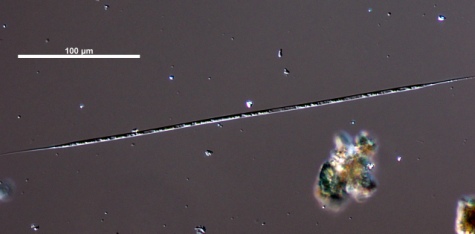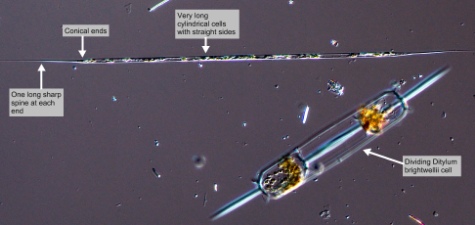



|
Synonym(s)
Rhizosolenia hensenii Schuett 1900
Pyxilla baltica Grunow 1881
Rhizosolenia pungens Cleve-Euler 1937
Rhizosolenia crassispina Schroeder
(EOL 2011)
Classification
(Guiry and Guiry 2011)
Lifestyle
Autotroph/autotrophic
An organism that can use inorganic materials for primary production of complex organic compounds by practicing photosynthesis or chemosynthesis. For example, plants are autotrophic organisms.
autotrophic centric diatom (Smithsonian 2012). It has both sexual and asexual cycles of reproduction (Guiry and Guiry 2011). R. setigera produces CloseResting spore
In diatoms, a cell that requires a dormancy period prior to germination and can survive for several years; usually developed to survive adverse conditions. They are commonly observed in centric but not pennate diatoms. The morphology of the spore may be similar or different from a vegetative cell; they usually have heavily silicified walls and are rich in storage products (Horner 2002).
resting spores, which are completely different from the mother cell (Horner 2002). Resting pores are torpedo-shaped and are formed in pairs (Smithsonian 2012).Description
Valve
In diatoms, the structurally distinct halves of the cell wall (Becker 1996).
valves narrowing into a long, straight and needle-like CloseSpine
In some diatoms, "closed or solid structures projecting from the cell wall;" in dinoflagellates, solid projections that usually taper to a point.
spine (Horner 2002, LUMCON 2012). Cells are much longer than they are wide and valves do not have CloseOtarium
(plural: otaria) In Rhizosolenia and related diatoms, an elongated, membranous thickening of the cell wall near the base of an external process. Otaria were previously called "wings" and can be seen as small lobes at the base of the needle-like spine at each end of a Rhizosolenia cell (Hasle and Syvertsen 1996).
otaria (EOL 2011). Cell frustule is weakly CloseSiliceous
Describing the character (i.e., white, shimmery) or chemical presence silicon dioxide (SiO2) as a component of phytoplankton cell covering.
silicified. R. setigera cells are wider in the centre and gently narrow towards either end (Hasle and Syvertsen 1996). Cell has many chloroplasts located through out the cell (Smithsonian 2012). Cells are often solitary (Horner 2002).Measurements
Diameter: 2 - 50 μm
(Horner 2002)
Similar species
Harmful effects
Habitat
Distribution
R. setigera is Close
Eurythermal
Describing organisms that are able to withstand a wide range of temperatures in the environment.
eurythermal (found in temperatures ranging from -2 - 30 °C) and CloseEuryhaline
Describing organisms that are able to withstand a wide range of salinities in the environment (e.g., fresh, brackish, salt).
euryhaline (found in salinity ranging from 1.5 - 37; EOL 2011). It is considered to be a north temperate species but has been seen throughout the world's oceans from tropical to cold temperate waters (Smithsonian 2012). R. setigera is not found in polar waters (EOL 2011).Environmental Ranges
Temperature range (°C): -1.765 - 29.468
Nitrate (μmol L-1): 0.053 - 15.539
Salinity: 24.029 - 35.840
Oxygen (mL L-1): 4.444 - 9.192
Phosphate (μmol L-1): 0.046 - 1.696
Close
Silicic acid
A general term to describe chemical compounds containing silicon, oxygen and hydrogen with a general formula of [SiOx(OH)4-2x]n. Diatoms polymerize silicic acid into biogenic silica to form their frustules (Azam and Chisholm 1976).
Silicate (μmol L-1): 0.648 - 37.729(EOL 2011)
Bloom characteristics
References
Encyclopedia of Life (EOL). 2011. Rhizosolenia setigera Brightwell 1858. http://www.eol.org. Accessed 11 Sept 2011.
Guiry, M. D. and Guiry, G. M. 2011. Rhizosolenia setigera Brightwell 1858. http://www.algaebase.org. Accessed 09 Sept 2011.
Haigh, N. 2010. Harmful Plankton Handbook. Nanaimo, BC. Canada. 53.
Hasle, G. R. and Syvertsen, E. E. 1996. Marine Diatoms. Tomas, C. R. (ed.) Identifying Marine Phytoplankton. Academic Press, Inc., San Diego, 531.
Horner, R. A. 2002. A Taxonomic Guide To Some Common Phytoplankton. Biopress Limited, Dorset Press, Dorchester, UK. 200.
Louisiana University Marine Consortium (LUMCON). 2012. Rhizosolenia setigera Brightwell 1858. http://phytoplanktonguide.lumcon.edu/display.asp?dtype=organism&id=258. Accessed 21 Jan 2012.
Smithsonian Institution. 2012. Rhizosolenia setigera Brightwell 1858. http://www.sms.si.edu/irlspec/Rhizos_setige.htm. Accessed 21 Jan 2012.
